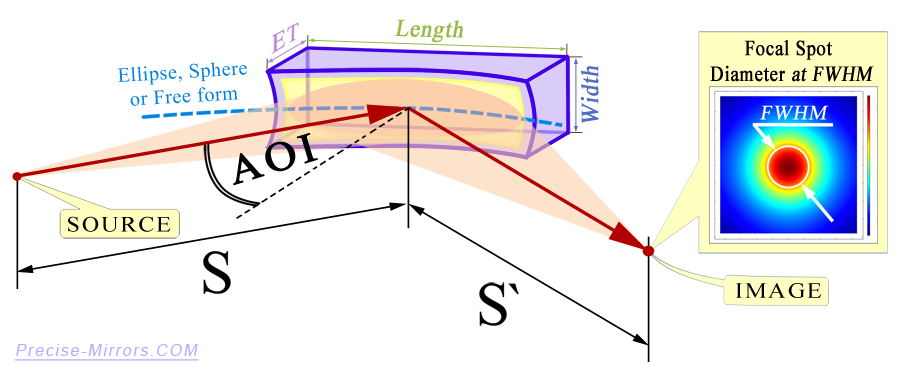
Toroidal mirrors, Ellipsoidal and Off axis parabolic mirrors.
If in the optical design used by the customer the angle of incidence of radiation on the mirror is large
(AOI > 70-75 degrees), then this is called a "grazing scheme". Most often such schemes
are used for mirrors operating in the short-wave region of the spectrum (wavelengths less than 100-150 nm), since
thanks to grazing angles of incidence of radiation, the reflectance of the coating can be significantly increased.
Commonly used
toroidal mirrors
or
elliptical mirrors,
in some special cases -
off-axis parabolic mirrors.
Toroidal mirrors
cost less than others, many know how to make them, but due to spherical distortions they very often give a bad result (even for cases
2f geometry - see example here -
and even for pairing in practice two identical toroids - see the third page of our typical quotation
with justification).
Ellipsoidal mirrors,
due to the fundamental absence of spherical aberrations, they are capable of producing very
a good result, the quality of which is essentially limited only by the accuracy of manufacturing the reflective
surfaces of such mirrors. But their disadvantage is their high price (especially if the “input arm” and “output arm” are
differ from each other, and their values are comparable with the physical values of the dimensions of the mirror itself).
Off-axis parabolic mirrors
used when necessary or from a diverging beam obtain a parallel collimated beam, or vice versa, focus radiation from a parallel beam
exactly. Also, off-axis parabolic mirrors are very well suited for solving the standard problem when
necessary first from divergent receive a parallel collimated beam from the radiation source, and then back
focus it to a point. Due to the absence of spherical distortions for this type of mirrors, off-axis parabolic
mirrors allow You to get very good results (as well as ellipsoidal ones). But they have the same drawback: high price.
Moreover, to produce an off-axis parabolic mirror with high precision and for large
angles of incidence - very difficult. We don't have data, something
Besides us, someone else in the world knows how to manufacture off-axis parabolic mirrors for
incidence angles of more than 70 degrees (the off-axis angle is more than 140 degrees) and at the same time with an accuracy better than λ/4 RMS (where λ=633 nm).
Simple arithmetic indicates that to work in the spectral range less than 50-100 nm You need to have, in the worst case, λ/50-λ/100; even λ/4 accuracy is not enough.
That is why, for this task, two identical toroidal mirrors are usually used in the world. In theory, this can give a good result,
but in practice, there are many important nuances that spoil everything (see, for example, our "standard quotation",
where exactly this issue is discussed on the third page).
| Mirror minimal and maximal sizes: | from 40 mm to 1200 mm | |
| Mirror substrate material: | Astrositall, by request: Zerodur, UV FS, Si and other. | |
| Coatings: | Metallic (Ag, Au, Al) and special EUV|XUV. | |
| Manufacture accuracy (RMS, λ=633 nm) | Base | Maximal |
| surface shapes, spherical mirrors | up to λ/140 | up to λ/400 |
| surface shapes, aspherical mirrors | up to λ/100 | up to λ/300 |
| Radiuses manufacture accuracy | up to ±0.05% | up to ±0.001% |
| Surface microroughness, RMS | 0.3 nm | 0.15 нм |
| Cosmetic quality (per square inch) | 40/20 scratch/dig | 10/5 scratch/dig |
Typically, it is very important for the customer how small a spot in the image plane can be formed by the mirror (see figure below). Even if used circuit where S' is equal to infinity (collimated beam after reflection), this parameter allows You to estimate how good the output beam will be.

The size of the focused spot in the image plane can be influenced by many different factors, but from actual practice these are mainly spherical aberrations, manufacturing precision of the mirror surface shape, and sometimes diffraction limitations at the operating wavelength. Also, the accuracy of the adjustment is often extremely important, since sometimes e.g. position error mirrors only a few microns can increase the diameter of the focused spot several times.
The general principle is that the closer the size
focused spot
to the diffraction limit, the more expensive such a mirror.
It depends on Your task and allocated for the purchase of finance. The most competent and correct way would be to fill out our special "request form" (here it is help in filling out (pdf)). It is also advisable to attach to the request form a description of Your optical design (at least in words), in which the mirror will operate and all this send to our email quote@precise-mirrors.ru. Next, our specialists will select several suitable options for You (see example of a typical quote for single mirror or for two conjugate mirrors).
You can also send a detailed exact specification of the mirror You need with drawings, a description of the type of surface shape, calculated radii, with all tolerances, etc. But even in this case, it is better to add at least minimal information on the angle of incidence, the size of the source and desired size of images. From our extensive practice, in such cases it is often possible to at least optimize the radius, with which the result will be slightly better and with In this case, the customer does not bear any additional costs.
You also don’t have to fill out "request form", and not send detailed exact specifications of the mirror You need, but instead of this send a description Your task (mirror) in any form on same email address quote@precise-mirrors.ru. But in this case, such a request may take much longer to process.